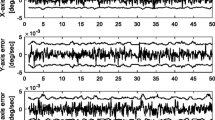Yet better the excess than the defect. Henry Wadsworth Longfellow (1807–1882) Morituri Salutamus (1875)
Abstract
Two effective measurements are examined which represent attitude information defectively, that is, part of the information is discarded in the effective measurement. These effective measurements are tested for the fusion of a star-tracker attitude estimate with a direction measurement from a vector Sun sensor. The defective directions tested are the Brozenec-Bender vector and those in the prescription of Bar-Itzhack and Harman. These are compared with maximum-likelihood estimation based on all measurements and with the startracker attitude estimate alone. Naturally, the approximate algorithms do not perform as well as maximum-likelihood estimation without approximation.
Similar content being viewed by others
References
SHUSTER, M. D. “Effective Direction Measurements for Spacecraft Attitude: I. Equivalent Directions,” The Journal of the Astronautical Sciences, Vol. 55, No. 4, October–December 2007, pp. 463–478.
SHUSTER, M. D. “Effective Direction Measurements for Spacecraft Attitude: II. Predicted Directions,” The Journal of the Astronautical Sciences, Vol. 55, No. 4, October–December 2007, pp. 479–492.
SHUSTER, M. D. “The Generalized Wahba Problem,” The Journal of the Astronautical Sciences, Vol. 54, No. 2, April–June 2006, pp. 245–259.
WAHBA, G. “Problem 65–1: A Least Squares Estimate of Spacecraft Attitude,” SIAM Review, Vol. 7, No. 3, July 1965, p. 409.
SHUSTER, M. D. and OH, S. D. “Three-Axis Attitude Determination from Vector Observations,” Journal of Guidance and Control, Vol. 4, No. 1, January–February 1981, pp. 70–77.
SHUSTER, M. D. “Maximum Likelihood Estimation of Spacecraft Attitude,” The Journal of the Astronautical Sciences, Vol. 37, No. 1, January–March, 1989, pp. 79–88.
MARKLEY, F. L. and MORTARI, M. “Quaternion Attitude Estimation Using Vector Measurements,” The Journal of the Astronautical Sciences, Vol. 48, Nos. 2 and 3, April–September 2000, pp. 359–380.
CHENG, Y. and SHUSTER, M. D. “Robustness and Accuracy of the QUEST Algorithm,” presented as paper AAS-07-102 at the 17th Space Flight Mechanics Meeting, Sedona, Arizona, January 28–February 2, 2007; Proceedings: Advances in the Astronautical Sciences, Vol. 127, 2007, pp. 41-61.
CHENG, Y. and SHUSTER, M. D. “The Speed of Attitude Estimation,” presented as paper AAS-07-105 at the 17th Space Flight Mechanics Meeting, Sedona, Arizona, January 28–February 2, 2007; Proceedings: Advances in the Astronautical Sciences, Vol. 127, 2007, pp. 101-116.
BROZENEC, T. F. and BENDER, D. J. “A Simple Suboptimal Least-Squares Algorithm for Attitude Determination with Multiple Sensors,” Proceedings, Flight Mechanics/Estimation Theory Symposium, NASA Goddard Space Flight Center, Greenbelt, Maryland, May 17–19, 1994, pp. 529–743.
BAR-ITZHACK, I.Y. and HARMAN, R.H. “Optimal Fusion of a Given Quaternion with Vector Measurements,” Journal of Guidance, Control and Dynamics, Vol. 25, No. 1, January–February 2002, pp. 188–190.
SHUSTER, M. D. “A Survey of Attitude Representations,” The Journal of the Astronautical Sciences, Vol. 41, No. 4, October–December 1993, pp. 439–517.
SHUSTER, M. D. “Constraint in Attitude Estimation Part I: Constrained Estimation,” The Journal of the Astronautical Sciences, Vol. 51, No. 1, January–March 2003, pp. 51–74.
CHENG, Y., CRASSIDIS, J. L., and MARKLEY, F. L. “Attitude Estimation for Large Field-of-View Sensors,” The Journal of the Astronautical Sciences, Vol. 54, Nos. 3 and 4, July–December 2006, pp. 433–448.
LEFFERTS, E. J., MARKLEY, F. L., and SHUSTER, M. D. “Kalman Filtering for Spacecraft Attitude Estimation,” Journal of Guidance, Control and Dynamics, Vol. 5, No. 5, September–October 1982, pp. 417–429.
VAROTTO, S. E. C., ORLANDO, V., and LOPES, R. V. F. „Um procedimento para determinação da atitude de satélites artificiais utilizando técnicas de estimação ótima estática e dinâmica,” Atas, 6°: Congresso Brasileiro de Automática, Belo Horizonte, 1986, p. 946–951.
SHUSTER, M. D. “Kalman Filtering of Spacecraft Attitude and the QUEST Model,” The Journal of the Astronautical Sciences, Vol. 38, No. 3, July–September 1990, pp. 377–393; Erratum: Vol. 51, No. 3, July–September 2003, p. 359.
SHUSTER, M. D. “A Suboptimal Algorithm for Attitude Determination from Multiple Star Cameras,” presented as paper No. AAS-00-124 at the AAS/AIAA Space Flight Mechanics Meeting, Clearwater, Florida, January 23–26, 2000; Proceedings: Advances in the Astronautical Sciences, Vol. 105, 2000, pp. 383-394.
SHUSTER, M. D. “SCAD-A Fast Algorithm for Star Camera Attitude Determination,” The Journal of the Astronautical Sciences, Vol. 52, No. 3, July–September 2004, pp. 391–404.
MARKLEY, F. L., ANDREWS, S. F., O’DONNELL, J. R., and WARD, D.K. “Attitude Control System of the Wilkinson Microwave Anisotropy Probe,” Journal of Guidance, Control and Dynamics, Vol. 28, No. 2, May–June 2005, pp. 385–397.
VAN BBEEZOOIJEN, R.W. H., ANDERSON, K. A., and WARD, D.K. “Performance of the AST-201 Star Tracker for the Microwave Anisotropy Probe,” presented as paper 2002–4582 at the AIAA Guidance, Navigation, and Control Conference, August 5–8, 2002, Monterey, California.
Author information
Authors and Affiliations
Corresponding author
Rights and permissions
About this article
Cite this article
Shuster, M.D. Effective direction measurements for spacecraft attitude: III. Defective directions and data fusion. J of Astronaut Sci 55, 493–510 (2007). https://doi.org/10.1007/BF03256538
Published:
Issue Date:
DOI: https://doi.org/10.1007/BF03256538




